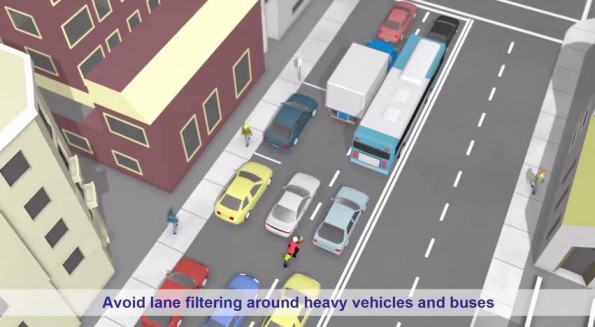A week ago, on July 1 motorcycle lane filtering became legal with some strict conditions, and Transport for NSW has created a video that nicely explains the rules.
Lane filtering is when a motorcycle rider moves alongside or between vehicles that have either stopped or are moving slowly (less than 30kph). It’s common in other countries, particularly the UK, where it’s taught by motorcycle instructors.
What motorcyclists need to know about safe lane filtering
- It’s now legal, since 1 July 2014, but with strict conditions
- Traffic must be seen to be making limited progress, and therefore motorcyclists must only lane filter when travelling less than 30kph, or when traffic is stationary
- A new offence called ‘lane splitting’ has been introduced for motorcyclists that filter dangerously or at speeds over 30kph. There are heavy fines and three demerit points.
- It is illegal for motorcyclists to lane filter next to the kerb, next to parked vehicles and in school zones during school zone hours. Filtering next to the kerb puts pedestrians at risk, and also means that vehicles turning left could cross your path. Filtering next to parked cars puts motorcyclists are risk of being knocked off if a car door is opened, and also makes it more dangerous for pedestrians accessing their vehicles
- Pedestrians and cyclists might also use the gaps in between vehicles when they are stationary therefore motorcyclists should be especially careful
- Motorcyclists should not lane filter around heavy vehicles and buses as they obstruct your view and could lead to a collision with a pedestrian. With a heavy vehicle, if you fall, there is a greater likelihood you will end up under the wheels of the trailer than if you fall next to a car. Drivers of heavy vehicles and buses have more blind spots and find it more difficult to see smaller road users such as motorcyclists. Also, because heavy vehicles and buses are larger, they take up more of the lane and therefore there will be less room to filter.
- Only fully licensed motorcyclists are allowed to lane filter – you cannot lane filter if you are on your Ls or Ps.
- Motorcyclists must only lane filter when it’s safe – this is a grey area guideline as defining ‘safe’ is difficult. However, examples that could be dangerous are if it’s raining with low visibility, or there’s sunstrike/sun dazzle, or there are likely to be many pedestrians around (e.g. bus stops, shopping areas, etc), or there is minimal distance between vehicles
- Motorcyclists must comply with all existing road rules when lane filtering. This includes stopping before the stop line at a red traffic light or stop sign, never in front or over it
- There must be enough room for you to filter. This will partly depend on the size of your motorbike as a Goldwing is going to be more difficult to filter with than a 125cc commuter bike.
- Pay particular attention around light vans and SUVs which may block your view.

Safety information for other road users
Motorists
Motorists should always check twice for motorcycles. Motorists should check that their mirrors are adjusted to see as much of the adjacent lanes as possible.
Motorists should not deliberately move into the path of a motorcyclist who is lane filtering. If you see a motorcyclist approaching in your wing mirrors or rear-view mirror, you can help give them plenty of room by changing your lane position slightly.
Pedestrians
Pedestrians should always cross at pedestrian crossings or traffic lights where they are available. Crossing between stationary traffic will put you at risk of being hit by a filtering motorcyclist.
Motorcyclists are being advised not to lane filter near parked vehicles or buses. Take particular care when crossing near vans and SUVs that may block your view.
Cyclists
Cyclists should always check twice for motorcycles. Cyclists are allowed to filter next to the kerb, while motorcyclists are not.

[…] done a lot in this space over the last few months. In July, we introduced lane filtering, which we know can be safe if done […]